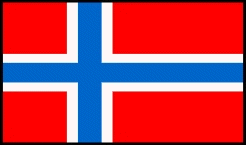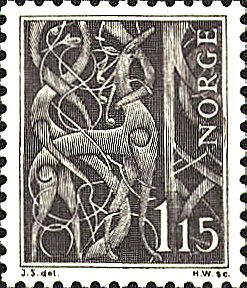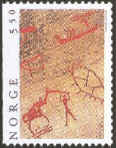
Bryggen, the old wharf of Bergen, had buildings on the site before King Olav Kyrre gave Bergen city status in 1070 and was the seat of the Hanseatic League of Merchants for 400 years beginning in 1360. It is comprised of beautiful wooden houses that have been lost to the city's many fires. The buildings were rebuilt after a devastating fire in 1702 burned the entire city to the ground. The remnants of the Hansa period's city structure is inscribed at a World Heritage Site.


The Urnes (sometimes spelled Ornes) stave church in Luster, Sognefjord, built in the second half of the twelfth century, contains a 100 year older church doorway. It is believed to be the oldest church of its kind. A four-legged animal beset by dragons is the main motif on the jambs.
Røros is
an historic copper mining town with colorful
wooden houses in a picturesque setting.
Cooper ore was discovered in the Røros mountains
in 1644. Two years later, Røros Copper Works was
established and produced copper and sulphur pyrite until 1977.
The town, the Femundshytta smelter and the Winter Transport Route
have been included in the World Heritage Listing.

Alta has one of the largest known collections of rock carvings made by hunter-gatherers and they went unnoticed until they were uncovered in 1973. The rock art in Alta is between 6200 and 2000 years old. They were made in the bedrock by hammer and chisel.
A cluster of dozens of islands centered on Vega, just south of the Arctic Circle. The islands are an example of life based on fishing and harvesting the down of eider ducks in an inhospitable environment which have been taking place here for ten thousand years.
The two fjords, among the worlds longest and deepest, are considered as archetypical fjord landscapes and among the most scenically outstanding anywhere.
Joint listing: Belarus, Estonia, Finland, Latvia, Lithuania, Norway, Republic of Moldova, Russian Federation, Sweden, Ukraine
The Struve Arc is a chain of survey triangulations running through ten countries and over 2,820km (1752 miles) from Hammerfest in Norway to the Black Sea. The survey was carried out between 1816 and 1855 by the astronomer Friedrich Georg Wilhelm Struve, and represented the first accurate measuring of a long segment of a meridian. 34 of the original 265 station points are included in the listing.
Complex established by the Norsk-Hydro Company to manufacture artificial fertilizer from nitrogen in the air. The company towns of Rjukan and Notodden link workers' accommodation by rail and fery to ports where the fertilizer was loaded.
Lynn Salmon <>{
Last updated: May 6, 2021